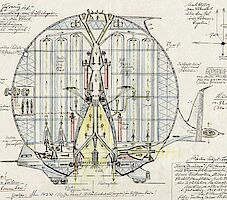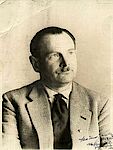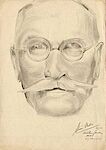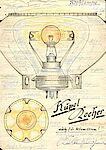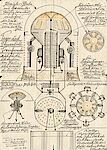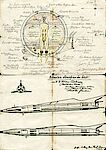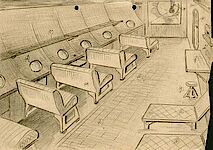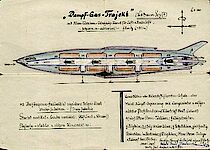Janke Archive
Karl Hans Janke
The "artist-inventor" from Hubertusburg
In cooperation with Rosengarten e.V., the Deutsche Fotothek’s image database (German Photographic Collection) presents a special archive containing about 3,500 images from a miraculous world: Spaceships, flying objects called "Trajects," and other construction drawings promise limitless trips, new kinds of propulsion devices, and never before seen inventions, such as, for example, the "radiation-free German atom".
Inspired by the Sputnik flight and the early years of space travel, Karl Hans Janke, who was a patient of a psychiatric clinic near Leipzig for nearly 40 years, developed his own unique visions of how locomotion would look in the future and of other worldwide technological developments.
Karl Hans Janke
Karl Hans Janke grew up as an only child in a lower middle-class family. After graduating from high school (Abitur) in 1941, he entered military service, which he was forced to end in 1943, due to his poor health.
In 1949, he was committed for the first time to a psychiatric clinic in Arnsdorf (Saxony) and was moved a year later to the Hubertusburg State Psychiatric Institution in Wermsdorf (Saxony).
The diagnosis of "chronic paranoid schizophrenia," to which his symptoms of "delusional inventing" and drawing were attributed, meant that he would remain in clinical care for the rest of his life – a time period of nearly 40 years, which resulted in the production of more than 4,000 drawings and models of Janke’s visionary flying objects, as well as other inventions of his.
After the rediscovery of this extraordinary body of graphic work in 2000 by Dr. Peter Grampp, the non-profit organisation Rosengarten e.V. was entrusted with the management of Janke’s estate.
An Outsider Artist
In Karl Hans Janke's work, portraits, such as that of his father Otto Hans Janke, or other depictions of people are rare; he was mainly interested in technical constructions. His drafts are crammed with meticulous descriptions of the objects he developed. These sheets, which are often completely covered with drawings and writings, are certainly an expression of Janke’s illness (a rare form of schizophrenia) and yet they are more than that – they have established his reputation as an outsider artist.
The starting point of Janke’s inventions were considerations for improving his immediate surroundings. He thought up light sources and cooking devices and even developed new energy sources, such as his idea for a "daylight and sunlight transformer".
In spite of his considerable technical abilities and his extremely detailed drawings, the constructions are not operational.
The Dream of Being a Space Pioneer
Construction ideas for aircraft that would allow man to travel beyond earth’s boundaries and investigate the universe are the main subject in Karl Hans Janke's drawings. In them, he imagined himself to be a space pioneer, the one who would make it possible for passengers to explore space from the cabins of the "Trajects" he designed.
For the various types of "Trajects," Janke developed different types of propulsion, ranging from "steam gas engines" (ill. 3) to the "fastest machine in the world" (ill. 1), powered "by 3 atomic turbines (German atom)".
You can search the Janke Archive with the search function at arthistoricum.net or from within the Deutsche Fotothek image database.
